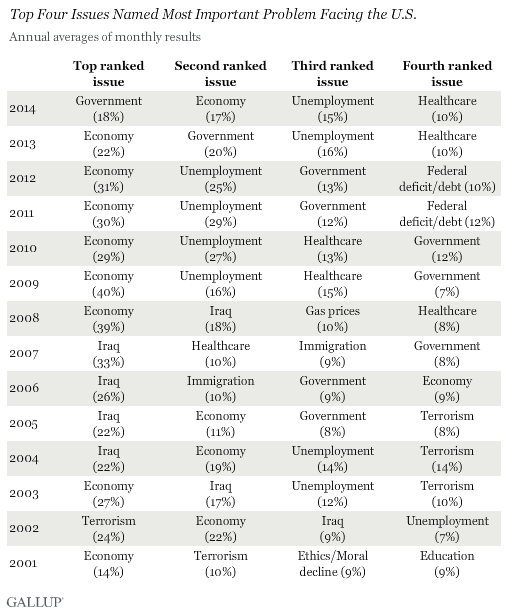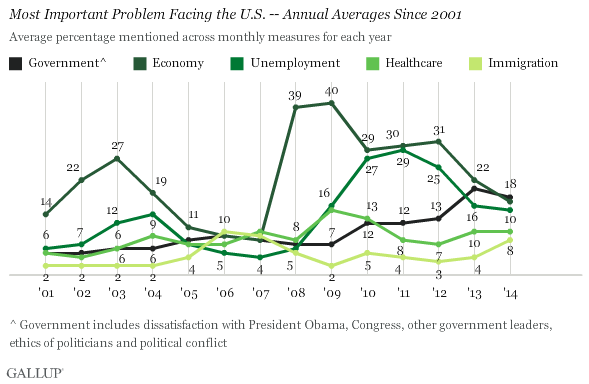1/3/2015
Cluster of Concerns Vie for Top U.S. Problem in 2014



Cluster of Concerns Vie for Top U.S. Problem in 2014
PRINCETON, N.J. -- In 2014, four issues generated enough public concern over enough months for at least 10% of Americans, on average, to identify each of them as the nation's most important problem. Complaints about government leadership -- including President Barack Obama, the Republicans in Congress and general political conflict -- led the list, at 18%. This was closely followed by mentions of the economy in general (17%), unemployment or jobs (15%) and healthcare (10%).

Beyond the top four issues, 8% of Americans named immigration as the country's most important problem, while 6% mentioned the federal budget deficit or debt and 5% cited ethical or moral decline. All other issues received less than 5% average mentions in 2014.
Some of the issues troubling Americans received uneven attention during the year. In particular, mentions of unemployment were consistently higher in the first half of 2014 than later in the year, reaching 23% in February. Also, race relations, usually mentioned by no more than 2% of Americans as the nation's top problem, surged to 13% in December as recent legal decisions sparked protests nationwide against police treatment of blacks. Similarly, mentions of immigration spiked in July to 17% as thousands of undocumented children from Central and South America created a crisis at the southern U.S. border. But this is the first time since 2001 that no single issue averaged 20% or more for the year.
2014 was also the first year since 2007 that the economy was not the top ranking issue, and it was the first year ever in Gallup records that dissatisfaction with government topped the list. Without a dominant issue such as the economy, the Iraq War or terrorism crowding out other issues as they have in years past, this is also only the third time since 2001 when three issues garnered at least 15% in average mentions. Thus, 2014 joins 2013 and 2009 as years when multiple issues emerged as significant top-of-mind concerns for Americans.

Of the top five issues that most concerned Americans in 2014, the economy and unemployment are significantly less dominant than they were even two years ago. At the same time, concerns about government and immigration have been mounting, while concerns about healthcare have consistently simmered at a moderately high level since 2009.

Bottom Line
With unemployment and gas prices falling, the U.S. not being involved in any major wars and scaling back operations in Afghanistan, and no acts of domestic terrorism occurring, the factors that have caused Americans to converge on a single pressing concern in the past simply weren't present in 2014. Rather, as mentions of the economy and unemployment have dwindled since 2012, mentions of healthcare and government leadership have grown to join them, forming a set of comparably sized, moderate-level concerns that now define the public's view of what ails the nation.
Not only was this the average picture in 2014, but it remained the state of affairs in the last quarter, suggesting 2015 is starting on a similarly calm note. That is underscored by the significant improvement in the Gallup Economic Confidence Index in late December,reaching positive territory for the first time since before 2008.
The dispersion of public concern seen in 2014 may also have implications for the 2016 presidential election. Should it persist, the lack of a single defining public issue could make candidates' task of honing a message for the election more complex.
Survey Methods
Results for the monthly Gallup Poll Social Series surveys included in this analysis are based on telephone interviews conducted with a random sample of approximately 1,000 adults, aged 18 and older, living in all 50 U.S. states and the District of Columbia. The yearly averages from the combined results are based on the total sample of approximately 12,000 national adults, with a margin of sampling error of ±1 percentage point at the 95% confidence level.
Each sample of national adults includes a minimum quota of 50% cellphone respondents and 50% landline respondents, with additional minimum quotas by time zone within region. Landline and cellular telephone numbers are selected using random-digit-dial methods.
Learn more about how Gallup Poll Social Series works.
No comments:
Post a Comment